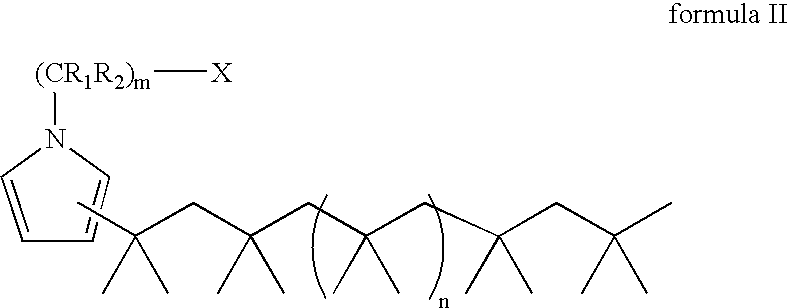Living and quasiliving cationic telechelic polymers quenched by N-substituted pyrrole and methods for their preparation
a telechelic polymer and quasi-living technology, which is applied in the field of manufacture and synthetic method for producing monodisperse telechelic polymers, can solve the problems of complex multi-step process, limited control of cationic polymerization, and less stable stability of cationic polymerization
- Summary
- Abstract
- Description
- Claims
- Application Information
AI Technical Summary
Benefits of technology
Problems solved by technology
Method used
Image
Examples
example 1
[0092]Linear monofunctional PIB was synthesized using the following conditions: Hexane / Methyl chloride (MeCl) 60 / 40 v / v; temperature −70° C.; [TMPCl]=0.014M; [TiCl4]=0.083 M; [2,6-DMP]=0.01 M; [IB]=0.5 M. Polymerizations were carried out under dry nitrogen gas in a glove-box. Masterbatch solutions (400 mL) including IB, solvent, TMPCl, and 2,6-DMP were allowed to mix thoroughly and reach thermal equilibrium for 15 min prior to initiation with TiCl4. Upon initiation, the polymerization solution was immediately divided into 30 mL aliquots (via a pre-chilled 50 mL graduated cylinder) and placed in 50 mL test tubes equipped with threaded caps. At the appropriate reaction time (98% IB conversion—determined from previous kinetic experiments) the polymerizations were terminated with either 10 mL prechilled MeOH (control) or quenched with a nucleophilic quenching agent.
[0093]Terminated reaction mixtures were allowed to warm to room temperature and low boiling components were volatilized. A ...
examples 4-6
[0099]Similar to the method utilized in Example 1, two additional sets of quenching trials were conducted using analogous quenching agents. The polymerizations and quenching reactions were carried out under the following sets of conditions: 1) MeCl; temperature −45° C.; [TMPCl]=0.024 M; [BCl3]=0.50 M; [2,6-DMP]=0.01 M; [IB]=0.6 M; 2) 1,2-EtCl2; temperature −10° C.; [TMPCl]=0.024 M; [BCl3]=0.25 M; [2,6-DMP]=0.01 M; [IB]=0.6 M. The time allowed for quenching equaled 70 minutes after 98% conversion of IB, for each condition. NMR and GPC were used to characterize the products and the data are listed in Table 2. As in the previous examples, bimodal samples exhibited much higher MWDs than unimodal samples (Examples 4 and 5). Comparative Examples A-3 through C-8 were also prepared in accordance with this method and the results are presented in Table 2.
[0100]
TABLE 2Ex-Quenching AgentQAQAGPC% Yieldbample(QA)(M)(g)TraceaRnx 11Rnx 2241-Methylpyrrole0.0480.12U206051-Furfurylpyrrole0.0120.05U61-...
example 7
[0101]A 2 L roundbottom flask was chilled to −70° C. Charged to the flask were 460 mL of anhydrous hexane, 307 mL of anhydrous methyl chloride, 21.24 g of 2-chloro-2,4,4-trimethylpentane (TMPCl), 1.16 mL 2,6-lutidine, and 161 mL of anhydrous isobutene (IB). The solution was stirred for 15 minutes. Polymerization was initiated by adding 47 mL of TiCl4 to the solution. After 3 minutes, 25.4 mL of 1-methyl pyrrole was added to quench the polymerization and allowed to react for 12 minutes to thereby functionalize the PIB chain end. To the reaction 120 mL of anhydrous MeOH was added, and the reaction was stopped.
[0102]Polymer samples were extracted from the mixture at intermittent reaction times and were added to separate scintillation vials containing 10 mL chilled, anhydrous MeOH. These samples were subjected to GPC analysis and NMR spectroscopic characterization.
[0103]The final PIB-substituted-N-methyl pyrrole was dissolved in hexane. The organic layer was washed with 5% v / v HCl / deion...
PUM
| Property | Measurement | Unit |
|---|---|---|
| weight percent | aaaaa | aaaaa |
| temperature | aaaaa | aaaaa |
| temperature | aaaaa | aaaaa |
Abstract
Description
Claims
Application Information
 Login to View More
Login to View More - R&D
- Intellectual Property
- Life Sciences
- Materials
- Tech Scout
- Unparalleled Data Quality
- Higher Quality Content
- 60% Fewer Hallucinations
Browse by: Latest US Patents, China's latest patents, Technical Efficacy Thesaurus, Application Domain, Technology Topic, Popular Technical Reports.
© 2025 PatSnap. All rights reserved.Legal|Privacy policy|Modern Slavery Act Transparency Statement|Sitemap|About US| Contact US: help@patsnap.com



